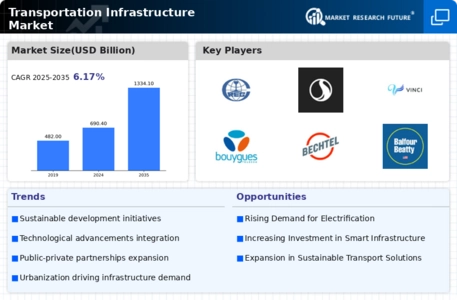Increasing Urbanization
The rapid pace of urbanization globally drives the demand for enhanced transportation infrastructure. As urban populations swell, cities require improved road networks, public transit systems, and airports to accommodate the growing number of residents. The Global Transportation Infrastructure Market Industry is projected to reach 690.4 USD Billion in 2024, reflecting the urgent need for investment in urban transport solutions. Governments are increasingly focusing on sustainable urban mobility plans, which may include expanding metro systems and developing smart transportation technologies. This trend indicates a significant shift towards integrated transport solutions that can effectively manage urban congestion and improve accessibility.
Market Growth Projections
The Global Transportation Infrastructure Market Industry is poised for substantial growth, with projections indicating a market size of 690.4 USD Billion in 2024 and an expected increase to 1334.1 USD Billion by 2035. This growth trajectory, characterized by a CAGR of 6.17% from 2025 to 2035, highlights the increasing demand for modernized transportation systems worldwide. Factors contributing to this growth include urbanization, government investments, and technological advancements. The market's expansion reflects the critical need for infrastructure that can support economic development, enhance connectivity, and improve the quality of life for populations globally.
Technological Advancements
Technological innovations are transforming the Global Transportation Infrastructure Market Industry, leading to more efficient and sustainable transport solutions. The integration of smart technologies, such as IoT and AI, into transportation systems enhances traffic management, reduces congestion, and improves safety. For example, smart traffic signals and connected vehicles can optimize traffic flow and minimize delays. As these technologies become more prevalent, they are expected to attract significant investments, further driving market growth. The anticipated CAGR of 6.17% from 2025 to 2035 indicates that the adoption of advanced technologies will likely play a pivotal role in shaping the future of transportation infrastructure.
Global Trade and Economic Growth
The dynamics of global trade and economic growth significantly impact the Global Transportation Infrastructure Market Industry. As international trade expands, the demand for efficient transportation networks becomes increasingly critical. Ports, railways, and highways must be developed and maintained to facilitate the smooth movement of goods across borders. The anticipated growth of the market to 1334.1 USD Billion by 2035 reflects the essential role of transportation infrastructure in supporting global commerce. Countries that invest in robust infrastructure are likely to enhance their competitiveness in the global market, attracting foreign investment and fostering economic development.
Government Investments and Policies
Government initiatives play a crucial role in shaping the Global Transportation Infrastructure Market Industry. Many countries are allocating substantial budgets to upgrade and expand their transportation networks, recognizing the economic benefits of efficient infrastructure. For instance, the United States has proposed significant funding for infrastructure projects, which may include highways, bridges, and rail systems. Such investments are expected to stimulate economic growth and job creation. By 2035, the market is anticipated to grow to 1334.1 USD Billion, suggesting that government policies will likely continue to prioritize infrastructure development as a means to enhance national competitiveness and connectivity.
Environmental Sustainability Initiatives
The increasing emphasis on environmental sustainability is reshaping the Global Transportation Infrastructure Market Industry. Governments and organizations are prioritizing eco-friendly transport solutions to reduce carbon emissions and promote sustainable practices. This includes investments in electric public transport systems, bike-sharing programs, and pedestrian-friendly infrastructure. The global push for greener transportation options is likely to influence infrastructure planning and development, as cities aim to create more sustainable urban environments. As a result, the market may witness a shift towards infrastructure projects that align with sustainability goals, potentially attracting new funding sources and partnerships.


















Leave a Comment